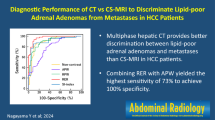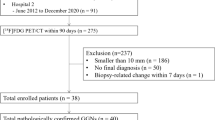Abstract
Objective
To investigate externally validated magnetic resonance (MR)–based and computed tomography (CT)–based machine learning (ML) models for grading clear cell renal cell carcinoma (ccRCC).
Materials and methods
Patients with pathologically proven ccRCC in 2009–2018 were retrospectively included for model development and internal validation; patients from another independent institution and The Cancer Imaging Archive dataset were included for external validation. Features were extracted from T1-weighted, T2-weighted, corticomedullary-phase (CMP), and nephrographic-phase (NP) MR as well as precontrast-phase (PCP), CMP, and NP CT. CatBoost was used for ML-model investigation. The reproducibility of texture features was assessed using intraclass correlation coefficient (ICC). Accuracy (ACC) was used for ML-model performance evaluation.
Results
Twenty external and 440 internal cases were included. Among 368 and 276 texture features from MR and CT, 322 and 250 features with good to excellent reproducibility (ICC ≥ 0.75) were included for ML-model development. The best MR- and CT-based ML models satisfactorily distinguished high- from low-grade ccRCCs in internal (MR-ACC = 73% and CT-ACC = 79%) and external (MR-ACC = 74% and CT-ACC = 69%) validation. Compared to single-sequence or single-phase images, the classifiers based on all-sequence MR (71% to 73% in internal and 64% to 74% in external validation) and all-phase CT (77% to 79% in internal and 61% to 69% in external validation) images had significant increases in ACC.
Conclusions
MR- and CT-based ML models are valuable noninvasive techniques for discriminating high- from low-grade ccRCCs, and multiparameter MR- and multiphase CT–based classifiers are potentially superior to those based on single-sequence or single-phase imaging.
Key Points
• Both the MR- and CT-based machine learning models are reliable predictors for differentiating high- from low-grade ccRCCs.
• ML models based on multiparameter MR sequences and multiphase CT images potentially outperform those based on single-sequence or single-phase images in ccRCC grading.



Similar content being viewed by others
Abbreviations
- ACC:
-
Accuracy
- ADC:
-
Apparent diffusion coefficient
- ccRCC:
-
Clear cell renal cell carcinoma
- CMP:
-
Corticomedullary phase
- CT:
-
Computed tomography
- GLCM:
-
Gray-level cooccurrence matrix
- GLDM:
-
Gray-level dependence matrix
- GLRLM:
-
Gray-level run-length matrix
- GLSZM:
-
Gray-level size-zone matrix
- GTDM:
-
Gray-tone difference matrix
- ML:
-
Machine learning
- MRI:
-
Magnetic resonance imaging
- NP:
-
Nephrographic phase
- NPV:
-
Negative predictive value
- PCP:
-
Precontrast phase
- PPV:
-
Positive predictive value
- RCC:
-
Renal cell carcinoma
- SPC:
-
Specificity
- TCGA-KIRC:
-
The Cancer Genome Atlas-Kidney Renal Clear Cell Carcinoma
- TPR:
-
True positive rate
References
Girgis H, Masui O, White NM et al (2014) Lactate dehydrogenase A is a potential prognostic marker in clear cell renal cell carcinoma. Mol Cancer 13:101
Dagher J, Delahunt B, Rioux-Leclercq N et al (2017) Clear cell renal cell carcinoma: validation of World Health Organization/International Society of Urological Pathology grading. Histopathology 71:918–925
Delahunt B, Eble JN, Egevad L, Samaratunga H (2019) Grading of renal cell carcinoma. Histopathology 74:4–17
Kim H, Inomoto C, Uchida T et al (2018) Verification of the International Society of Urological Pathology recommendations in Japanese patients with clear cell renal cell carcinoma. Int J Oncol 52:1139–1148
Halverson SJ, Kunju LP, Bhalla R et al (2013) Accuracy of determining small renal mass management with risk stratified biopsies: confirmation by final pathology. J Urol 189:441–446
Haifler M, Kutikov A (2017) Update on renal mass biopsy. Curr Urol Rep 18:28
Zhao J, Zhang P, Chen X, Cao W, Ye Z (2016) Lesion size and iodine quantification to distinguish low-grade from high-grade clear cell renal cell carcinoma using dual-energy spectral computed tomography. J Comput Assist Tomogr 40:673–677
Parada Villavicencio C, Mc Carthy RJ, Miller FH (2017) Can diffusion-weighted magnetic resonance imaging of clear cell renal carcinoma predict low from high nuclear grade tumors. Abdom Radiol (NY) 42:1241–1249
Aslan A, Inan I, Aktan A et al (2018) The utility of ADC measurement techniques for differentiation of low- and high-grade clear cell RCC. Pol J Radiol 83:e446–e451
Chen C, Kang Q, Xu B et al (2017) Differentiation of low- and high-grade clear cell renal cell carcinoma: tumor size versus CT perfusion parameters. Clin Imaging 46:14–19
Erickson BJ, Korfiatis P, Akkus Z, Kline TL (2017) Machine learning for medical imaging. Radiographics 37:505–515
Kocak B, Ates E, Durmaz ES, Ulusan MB, Kilickesmez O (2019) Influence of segmentation margin on machine learning-based high-dimensional quantitative CT texture analysis: a reproducibility study on renal clear cell carcinomas. Eur Radiol. https://doi.org/10.1007/s00330-019-6003-8
Bektas CT, Kocak B, Yardimci AH et al (2019) Clear cell renal cell carcinoma: machine learning-based quantitative computed tomography texture analysis for prediction of Fuhrman nuclear grade. Eur Radiol 29:1153–1163
Ding J, Xing Z, Jiang Z et al (2018) CT-based radiomic model predicts high grade of clear cell renal cell carcinoma. Eur J Radiol 103:51–56
Akin O, Elnajjar P, Heller M et al (2016) Radiology data from the cancer genome atlas kidney renal clear cell carcinoma [TCGA-KIRC] collection. Cancer Imaging Arch. https://doi.org/10.7937/K9/TCIA.2016.V6PBVTDR
Clark K, Vendt B, Smith K et al (2013) The Cancer Imaging Archive (TCIA): maintaining and operating a public information repository. J Digit Imaging 26:1045–1057
Yushkevich PA, Piven J, Hazlett HC et al (2006) User-guided 3D active contour segmentation of anatomical structures: significantly improved efficiency and reliability. Neuroimage 31:1116–1128
Koo TK, Li MY (2016) A guideline of selecting and reporting intraclass correlation coefficients for reliability research. J Chiropr Med 15:155–163
van Griethuysen JJM, Fedorov A, Parmar C et al (2017) Computational radiomics system to decode the radiographic phenotype. Cancer Res 77:e104–e107
Dorogush AV, Gulin A, Gusev G, Kazeev N, Prokhorenkova LO, Vorobev A (2017) Fighting biases with dynamic boosting. arXiv preprint arXiv:170609516
Dorogush AV, Ershov V, Gulin A (2018) CatBoost: gradient boosting with categorical features support. arXiv preprint arXiv:181011363. https://arxiv.org/abs/1810.11363
Hunter JD (2007) Matplotlib: a 2D graphics environment. Comput Sci Eng 9:90. https://doi.org/10.1109/MCSE.2007.55
Silverman SG, Israel GM, Herts BR, Richie JP (2008) Management of the incidental renal mass. Radiology 249:16–31
Heilbrun ME, Remer EM, Casalino DD et al (2015) ACR Appropriateness Criteria indeterminate renal mass. J Am Coll Radiol 12:333–341
Shu J, Tang Y, Cui J et al (2018) Clear cell renal cell carcinoma: CT-based radiomics features for the prediction of Fuhrman grade. Eur J Radiol 109:8–12
Kocak B, Durmaz ES, Ates E, Kaya OK, Kilickesmez O (2019) Unenhanced CT texture analysis of clear cell renal cell carcinomas: a machine learning-based study for predicting histopathologic nuclear grade. AJR Am J Roentgenol. https://doi.org/10.2214/AJR.18.20742
He X, Zhang H, Zhang T, Han F, Song B (2019) Predictive models composed by radiomic features extracted from multi-detector computed tomography images for predicting low- and high- grade clear cell renal cell carcinoma: a STARD-compliant article. Medicine (Baltimore) 98:e13957. https://doi.org/10.1097/MD.0000000000013957
Sun X, Liu L, Xu K et al (2019) Prediction of ISUP grading of clear cell renal cell carcinoma using support vector machine model based on CT images. Medicine (Baltimore) 98:e15022. https://doi.org/10.1097/MD.0000000000015022
Kocak B, Yardimci AH, Bektas CT et al (2018) Textural differences between renal cell carcinoma subtypes: machine learning-based quantitative computed tomography texture analysis with independent external validation. Eur J Radiol 107:149–157
Frank I, Blute ML, Cheville JC, Lohse CM, Weaver AL, Zincke H (2002) An outcome prediction model for patients with clear cell renal cell carcinoma treated with radical nephrectomy based on tumor stage, size, grade and necrosis: the SSIGN score. J Urol 168:2395–2400
Klatte T, Patard JJ, de Martino M et al (2008) Tumor size does not predict risk of metastatic disease or prognosis of small renal cell carcinomas. J Urol 179:1719–1726
Hori J, Kobayashi S, Tamaki G, Azumi M, Kakizaki H (2017) Diagnostic efficacy of percutaneous renal tumor biopsy - concomitant use of frozen section to accurately diagnose renal tumor with necrosis. Gan To Kagaku Ryoho 44:771–774
Deng Y, Soule E, Samuel A et al (2019) CT texture analysis in the differentiation of major renal cell carcinoma subtypes and correlation with Fuhrman grade. Eur Radiol. https://doi.org/10.1007/s00330-019-06260-2
Marconi L, Dabestani S, Lam TB et al (2016) Systematic review and meta-analysis of diagnostic accuracy of percutaneous renal tumour biopsy. Eur Urol 69:660–673
Funding
The authors state that this work has not received any funding.
Author information
Authors and Affiliations
Corresponding authors
Ethics declarations
Guarantor
The scientific guarantor of this publication is Wansheng Long.
Conflict of interest
The authors of this manuscript declare no relationships with any companies whose products or services may be related to the subject matter of the article.
Statistics and biometry
No complex statistical methods were necessary for this paper.
Informed consent
Written informed consent was waived by the Institutional Review Board.
Ethical approval
Institutional Review Board approval was obtained.
Study subjects or cohorts overlap
Some study subjects or cohorts were derived from TCGA public database (TCGA Research Network: http://cancergenome.nih.gov/), which could be used in other research.
Methodology
• Retrospective
• Diagnostic or prognostic study
• Multicenter study
Additional information
Publisher’s note
Springer Nature remains neutral with regard to jurisdictional claims in published maps and institutional affiliations.
Rights and permissions
About this article
Cite this article
Cui, E., Li, Z., Ma, C. et al. Predicting the ISUP grade of clear cell renal cell carcinoma with multiparametric MR and multiphase CT radiomics. Eur Radiol 30, 2912–2921 (2020). https://doi.org/10.1007/s00330-019-06601-1
Received:
Revised:
Accepted:
Published:
Issue Date:
DOI: https://doi.org/10.1007/s00330-019-06601-1




